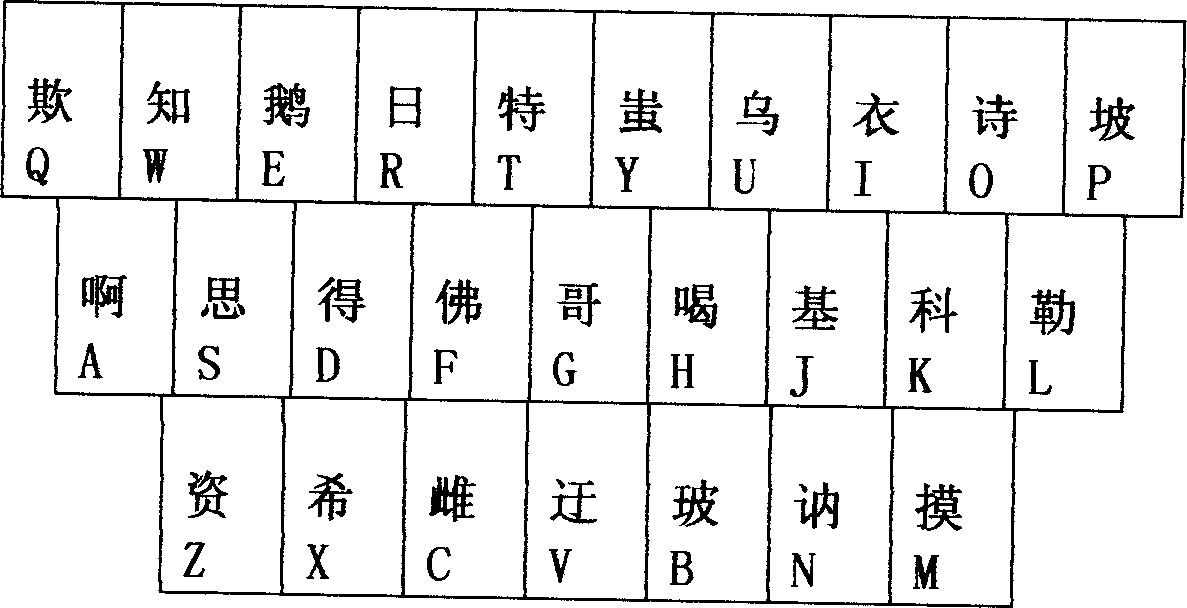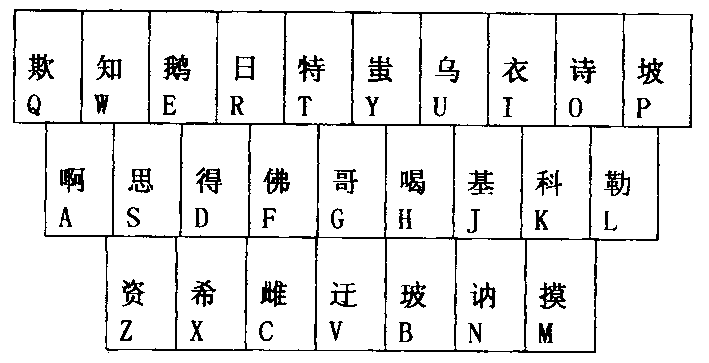Chinese character code element input method
A Chinese character input and code element technology, applied in the input/output process of data processing, electrical digital data processing, instruments, etc., can solve problems such as low efficiency, difficulty in learning, and inability to directly expand simplified and traditional Chinese characters.
- Summary
- Abstract
- Description
- Claims
- Application Information
AI Technical Summary
Problems solved by technology
Method used
Image
Examples
Embodiment 1
[0181] The Chinese characters "ice, one, case" are input into the computer with the code element input method.
[0182] The basic steps of the computer Chinese character input of the code element word are: first install the computer Chinese character input method software of this code element word; Require the corresponding code element word from the keyboard input Chinese character mark by the rule again, input: 1, prepare:
[0183] Operate according to Windows95 system 1) Create the original code table file (mvorf.txt)
[0184] In order to set up and install "code element input method version 1.0", the original code table file has been established for this Chinese character code element input method, and an input method application software has been made. The standard Chinese character code list is 6720 (including two traditional characters "dragon" and "turtle"), the file name is mvorf.txt, and the file carrier is a 3.5-inch floppy disk. See Table 5 for the original code t...
Embodiment 2
[0213] With the code element input method, Chinese characters: "疴, heavy, younger brother, fruit" are input into the computer. The preparatory work and identification steps are the same as those in Embodiment 1. 1. Divide Chinese characters into divisions by using the "Basic Writing Interpretation Method":
[0214] Example Word Subpart Example Word Subpart Part Example Word Subpart Part Example Word Subpart
[0215] Illness Illness Dingkou Day younger brother Pie Gong Guo Jia 18 wherein: 1) "疒"—is the block shape of the character parts "cancer"; "丷"—is the variant of the character parts "eight"; shape; " One" - is the stroke component; " "-is a parasitic part; "Dingkou Rigong Jiaba"-is the prototype of a character part.
[0216] 2) There are several kinds of "heavy" divisions, but they are all wrong divisions:
[0217] 2.1) heavy--thousand days two; 2.2) heavy-- 2.3) weight of soil per day-- Sun soil.
[0218] Word part " thousand " has only 3 strokes, ha...
Embodiment 3
[0245] Input the Chinese characters "冁, stupid, Hui, hub" into the computer. Marking step 1, with " starting to read and interpret method net Chinese character division. Example character Subpart part Example character Part part Example character Part part Example character Part part stupid Ri Chong Chong Hui Feng Feng Hu Xin Hub 11 冖 1 ∠ 10 and 2. Distinguish the apparent structure type of Chinese characters
[0246] A Chinese character composed of two or more component strings is a multi-string type apparent structure.
[0247] Example Word Font Type Description
[0248] 冁 type c "Piejiayi" is a vertical string of 3 parts, " " is a vertical string of 3 parts;
[0249] stupid c-type" 日" is a vertical string of 3 parts, and "Cong Chong" is a horizontal string of 2 parts;
[0250] Hui C type "Fengfeng" is a horizontal string of 2 parts, and "Heng Xin" is a vertical string of 2 parts:
[0251] Hub c type "11冖一∠十" is a vertical string of 6 parts, and "Jiyou" i...
PUM
 Login to View More
Login to View More Abstract
Description
Claims
Application Information
 Login to View More
Login to View More - R&D
- Intellectual Property
- Life Sciences
- Materials
- Tech Scout
- Unparalleled Data Quality
- Higher Quality Content
- 60% Fewer Hallucinations
Browse by: Latest US Patents, China's latest patents, Technical Efficacy Thesaurus, Application Domain, Technology Topic, Popular Technical Reports.
© 2025 PatSnap. All rights reserved.Legal|Privacy policy|Modern Slavery Act Transparency Statement|Sitemap|About US| Contact US: help@patsnap.com


